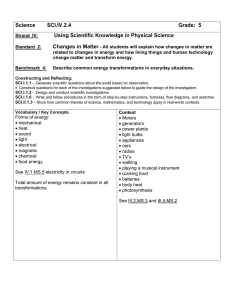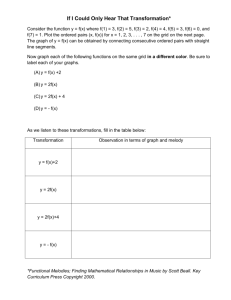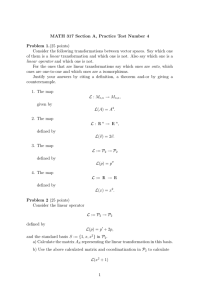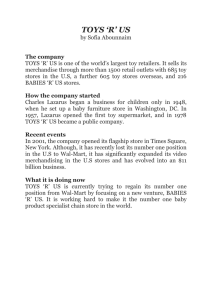Science SCI.IV.2.4 Grade: 6
advertisement
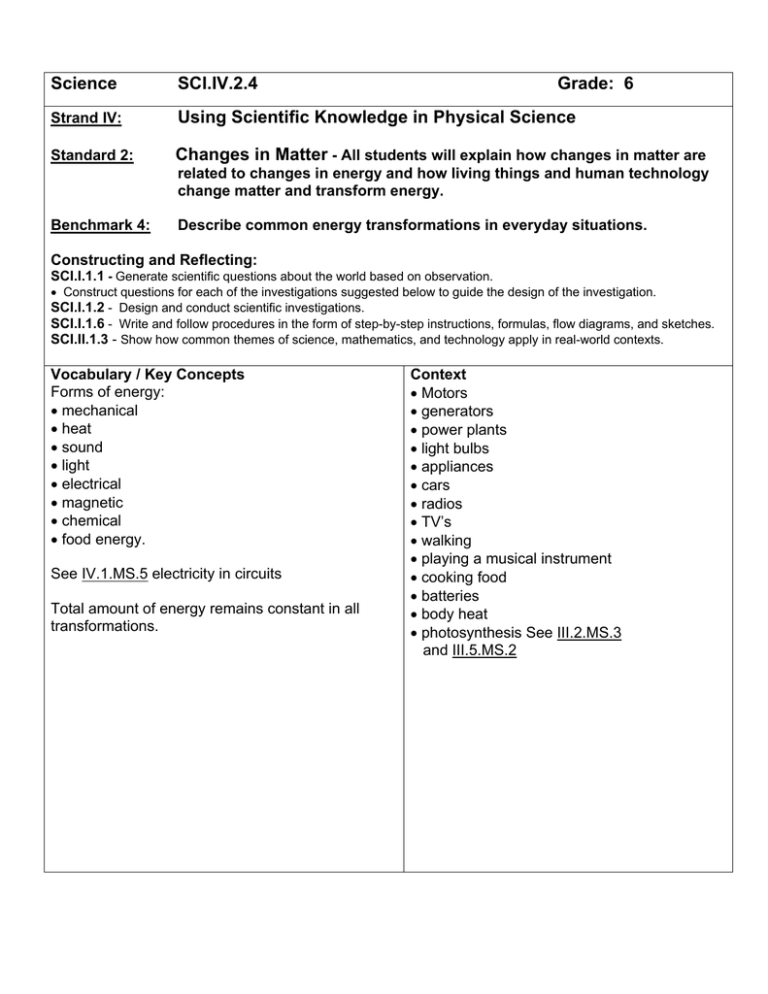
Science SCI.IV.2.4 Grade: 6 Strand IV: Using Scientific Knowledge in Physical Science Standard 2: Changes in Matter - All students will explain how changes in matter are related to changes in energy and how living things and human technology change matter and transform energy. Benchmark 4: Describe common energy transformations in everyday situations. Constructing and Reflecting: SCI.I.1.1 - Generate scientific questions about the world based on observation. • Construct questions for each of the investigations suggested below to guide the design of the investigation. SCI.I.1.2 - Design and conduct scientific investigations. SCI.I.1.6 - Write and follow procedures in the form of step-by-step instructions, formulas, flow diagrams, and sketches. SCI.II.1.3 - Show how common themes of science, mathematics, and technology apply in real-world contexts. Vocabulary / Key Concepts Forms of energy: • mechanical • heat • sound • light • electrical • magnetic • chemical • food energy. See IV.1.MS.5 electricity in circuits Total amount of energy remains constant in all transformations. Context • Motors • generators • power plants • light bulbs • appliances • cars • radios • TV’s • walking • playing a musical instrument • cooking food • batteries • body heat • photosynthesis See III.2.MS.3 and III.5.MS.2 Knowledge and Skills Resources Students will recognize that energy is never lost, destroyed, or created, it only changes form. Students will also describe the energy transformations in everyday systems (appliances, the body, plants, vehicles, musical instruments, toys, etc.). In each transformation, students should be introduced to the idea that the amount of energy that goes into a system is the same as the amount of energy that comes out of the system, as long as all types of energy are accounted for in analyzing how the system works. For example, a battery demonstrates chemical energy being transformed to electrical energy. Coloma Resources: Matter & Molecules, Chapter 6 Motion, Forces & Energy Text Energy & Power, Chapter 5 Students will demonstrate an understanding of the interdisciplinary links between math, science and technology by exploring careers and using every day objects. These disciplines integrate common thematic ideas such as: • Systems: a collection of parts that function as a whole • Model/Scale: a simplified proportional representation • Patterns of Change: natural or mathematical repetitions • Function: how an object works; its purpose • Evolution: the present arises from materials and forms of the past; change over time • Scale: a reference to a quality that is both relative and absolute and to the ranges of magnitude in the universe which include such dimensions as size, duration, and speed • Energy: the capacity to work or the ability to make matter move • Science Explosion • • Michigan Teacher Network Resources Energy Choices Webquest – looking at alternative energy sources and how they impact the world. • Teacher Resources – Webquests, lesson plans and much more – vetted by ENC. • Scope Unit Plan – Energy: Moving It and Using It Energy Education Curriculum Project Energy Conversions - Middle School Module 2 – interdisciplinary unit Other Resources • Teaching Science with Toys: Physics Activities for Grades K-9, Taylor, Poth and Portman Videoconferences Available For more information, see www.remc11.k12.mi.us/dl or call Janine Lim 471-7725x101 or email jlim@remc11.k12.mi.us IV.2.MS.4 Science of Sound from the Cleveland Institute of Music Energy from COSI Toledo Photosynthesis from Camden Children's Garden Instruction Focus Question: What kinds of energy transfers occur in various toys? Before beginning the explorations students should be familiar with energy and its forms (see key concepts). Also the teacher should perform/discuss everyday examples of energy transformations (burning coal to produce electricity, digestion of food, speakers, photosynthesis, etc.). Students will be given a toy that undergoes one or more energy transfers. They will investigate the mechanics of the toy and identify its energy transfers. Students will demonstrate and explain their discoveries. Toy examples: Tops, music box, Jack-in-the-Box, wind-up toys, push and pull toys, string-pull toys, battery-operated toys. Assessment Optional Assessment After students have investigated various energy transformations the following assessment can be used: Students will observe the energy transformation that occurs when 250-ml (1/2cup) cold water is combined with 15 grams (1 teaspoon) calcium chloride in a zipper-lock bag. Students will describe the energy transformation that is occurring and propose a real-life application. (Give students rubric before activity.) Scoring Rubric Criteria: Accuracy of description — energy transformation: Apprentice - Describes an observation that does not include an energy transformation. Basic - Describes the energy transformation with no details. Meets - Describes the energy transformation with some details. Exceeds - Describes the energy transformation with many details. Criteria: Accuracy of Description-realworld application: Apprentice - Does not describe a real-world application. Basic - Describes a real-world application with no details. Meets - Describes a real-world application with some details. Exceeds - Describes a real-world application with many details. Teacher Notes: The battery or other source provides energy to the electrical current, which is transformed in the circuit devices to other forms of energy (light, heat, sound, motion, etc.) Energy is neither created nor destroyed in this process; it only transforms from one form to another. Focus Questions • What is energy and how does it transfer from one substance to another in everyday situations?
